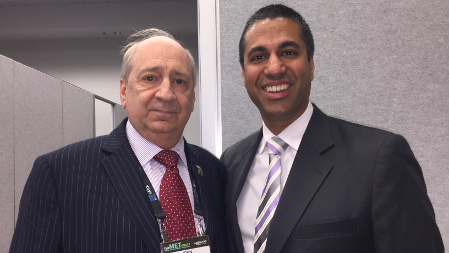John Lyons: Dedicated to Big Apple Broadcasting
When it comes to managing and promoting the health of over-the-air broadcasting in the nation’s largest media market, it would be hard to find a bigger advocate than John Lyons, the recipient of this year’s NAB Television Engineering Achievement Award.

John Lyons with FCC Chairman Ajit Pai at the 2017 NAB Show
As the assistant vice president and director of broadcast communications for The Durst Organization, a New York City-based office tower and residential building management company, John is responsible for the communications needs of the entire 13 million-square-foot Durst commercial portfolio. John has held various positions within the communications industry for over 50 years and has received numerous awards for his work with broadcasters and first responders.
John played an important role in getting broadcasters back on the air in New York after the fall of the World Trade Center on Sept. 11, 2001. He also spearheaded the design and implementation of the redesigned master antenna at 4 Times Square and more recently the new broadcast transmission facility at One World Trade Center.
I had a chance to talk with John recently about his career, what drove him to enter broadcasting and his reflections on the aftermath of 9/11 on the broadcast industry and plans to bring television and radio broadcasting back to a new World Trade Center.
Technology has always played an important role in John’s life, ever since he chose the electronics and broadcast class regimen at Brooklyn Technical High School. After graduating with a first class radio telephone operator’s license, he began looking for a job while attending college in the city.
“I was taking the subway back and forth and I would pass this antenna tower not too far from where I lived, so one day I stopped by to see if they had any openings,” John said. “I asked ‘do you have any openings where you have to have a license?’, they said ‘yes, do you have any experience?’; I said ‘no,’ and they replied ‘when can you start?’ I started working midnight that night.”
So on Sept. 15, 1966, John went to work for WRFM-FM (now WWPR). Over his 50-year career, he gravitated from radio to television, before landing with The Durst Org. in 2002. But as the go-to guy for managing the broadcast transmission facilities atop One World Trade Center, John works with both radio and television.
It’s a question he often gets, but I couldn’t help ask him about that fateful day when the towers collapsed, killing thousands, (several of which were dedicated broadcast personnel), and crippling over-the-air broadcast in New York for several months.
John was asleep when the planes hit, having spent most of the previous evening testing at Times Square. He was awoken by a phone message from a colleague on the west coast, asking “Hey John, it’s Ron, what’s going on at the World Trade Center? We’ll keep you in our prayers.’
“I knew it had to be something more than just a little incident,” John said. “It’s one [message] I’ll never forget.”
At the time, John was consulting for Durst but soon thereafter, found himself in the middle of coordinating a massive transition to install backup broadcast antennas at the Empire State Building. It was shortly after that that he took the full-time position at Durst.
“[After 9/11], I spent the next couple of weeks living at the Empire State Building, literally day and night, trying to get the stations back on the air, doing whatever I could get the FMs and some of the TVs on,” he said. Two-and-a-half years after the opening of One World Trade Center, over-the-air television broadcasting is set to commence with WCBS, NBCUniversal-owned WNBC and WNJU and WNET all committing to 1 WTC.
Although some lessons were learned in the aftermath of 9/11 about protection against future attacks, John is realistic. “It’s still in the back of my head as something that could happen again,” he said. “Anybody who was in the city at that time, that thought is never going to vanish.”
John will receive his award at the NAB Show Technology Luncheon, Wednesday, April 26.
Get the TV Tech Newsletter
The professional video industry's #1 source for news, trends and product and tech information. Sign up below.
Tom has covered the broadcast technology market for the past 25 years, including three years handling member communications for the National Association of Broadcasters followed by a year as editor of Video Technology News and DTV Business executive newsletters for Phillips Publishing. In 1999 he launched digitalbroadcasting.com for internet B2B portal Verticalnet. He is also a charter member of the CTA's Academy of Digital TV Pioneers. Since 2001, he has been editor-in-chief of TV Tech (www.tvtech.com), the leading source of news and information on broadcast and related media technology and is a frequent contributor and moderator to the brand’s Tech Leadership events.

